I suspect that there are very few places left on this planet that haven’t been discovered by intrepid explorers. Yet, Trevor Paglen has found and investigated territories that still need to be documented and exposed to the world. If you’ve never seen his photographs, i suggest you swing by the Z33 House for Contemporary Art Center in Hasselt, Belgium. They are part of Architecture of Fear, an exhibition that examines how feelings of fear pervade our daily life.
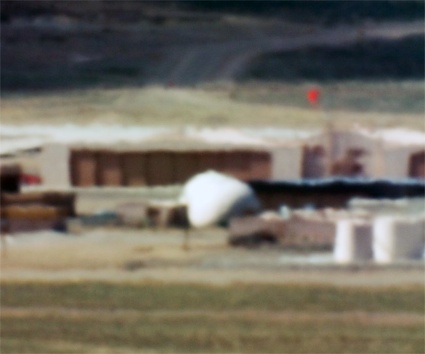 Trevor Paglen, Large Hangars and Fuel Storage. Tonopah Test Range, NV. Distance ~ 18 miles
Trevor Paglen, Large Hangars and Fuel Storage. Tonopah Test Range, NV. Distance ~ 18 miles
For his Limit Telephotography series, Paglen used high powered telescopes to picture the “black” sites, a series of secret locations operated by the CIA. Often outside of U.S. territory and legal jurisdiction, these locations do not officially exist, they range from American torture camps in Afghanistan to front companies running airlines whose purpose is to covertly move suspects around.
Paradoxically Paglen’s images deepen the secrecy of their subject rather than uncover it. Limit-telephotography most closely resembles astrophotography, a technique that astronomers use to photograph objects that might be trillions of miles from Earth. Paglen’s subjects are much closer but also even more difficult to photograph. To physical distance, one has indeed to add the obstacle of informational concealment.
The other photos the artist is showing at Z33 are part of The Other Night Sky which tracks and documents classified American satellites in Earth orbit. With the help of a network of amateur “satellite observers” and of a specially designed software model able to describe the orbital motion of classified spacecraft, Paglen could calculate the position and timing of overhead reconnaissance satellite transits. He would then photograph their passage using telescopes and large-format cameras .
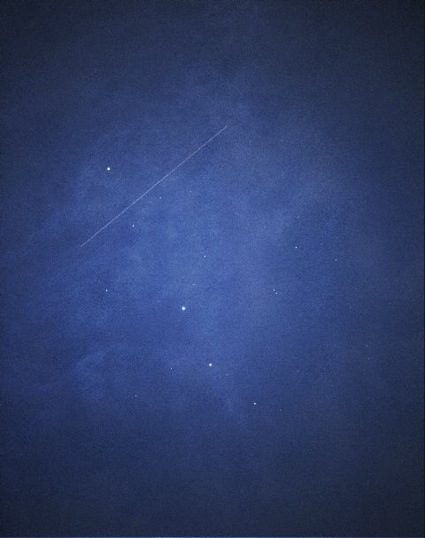 Trevor Paglen, LACROSSE ONYX II, from The Other Night Sky
Trevor Paglen, LACROSSE ONYX II, from The Other Night Sky
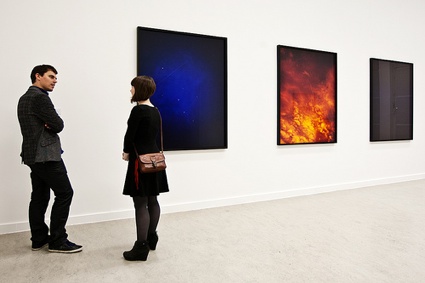 Opening Architecture of Fear. Photo: Kristof Vrancken / Z33
Opening Architecture of Fear. Photo: Kristof Vrancken / Z33
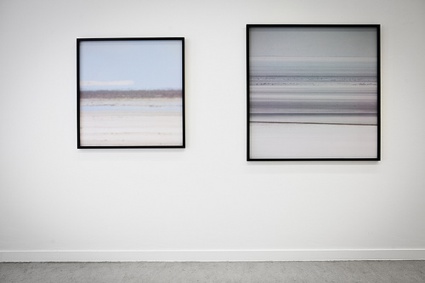 Trevor Paglen, Limit Telephotography 2007. View at the Architecture of Fear exhibition. Photo: Kristof Vrancken / Z33
Trevor Paglen, Limit Telephotography 2007. View at the Architecture of Fear exhibition. Photo: Kristof Vrancken / Z33
I’ve seen his works in numerous contexts, from new media art festivals to activist conferences and contemporary art exhibitions. However, the more you see Paglen’s work, the more questions you want to ask him. I’ve finally decided to catch up with him and interviewed him via skype for the upcoming Z33 catalogue:
How does you desire to document and reveal coexist with the need to express yourself as an artist? How does your formation as a geographer feeds your art practice and vice-versa?
I guess it’s all mixed-up. For me it’s difficult to dissociate what is geography from what is art or journalism in my practice. Art has its own methods and the same is true for geography and journalism. Each field can give you ways to ask questions and communicate that other fields can’t give you. What i’ve tried to do is make things a bit more complicated. There are artists pretending to be anthropologists or scientists but i’ve asked myself “What happens if art is not some sort of degraded, diluted form of pseudo social science or geography but if it is actually also geography or social science in its own right?” I’ve always been an artist but ten years ago i started studying geography and social science and i’m trying to be as good at it as someone for whom this is the main profession.
Isn’t all this government secrecy a bit disheartening sometimes? It seems to have no boundaries nor end, it even appears to keep on growing. Do you ever feel like it’s time to close the chapter and dedicate your time to a subject that is easier to circumvent? What keeps you going?
Nothing is particularly easy to understand. People have tried for thousands of years to understand flowers.
In my case the question is about secrecy and i’m interested in the aesthetics of it as much as i’m interested in politics. How does the State look like now? And looking at secrecy is part of who we are now.
I’m also interested in the history behind the individual images of “Limit Telephotography”. How much time, energy does it typically take to get one of those images? How much research do you have to make, miles to go, people to contact?
It’s different from one image to another. Each of them has taken enormous time to make. The places they picture are very remote and it takes a long time to get there. I often travel from the Bay Area and it can take a 10 hour-drive to get to my destination. After that i have to hike with my telescope and heavy backpacking.
The other thing is that photographs don’t look very good the first time so i have to come back time and time again. One photo took me six years. I went to the location twice every year until i got the image i wanted. That can happen not only because the conditions are not what i want but also because i learn a lot in the process, i learn how to see the place. I need some time before i can understand how a place should look like in photo.
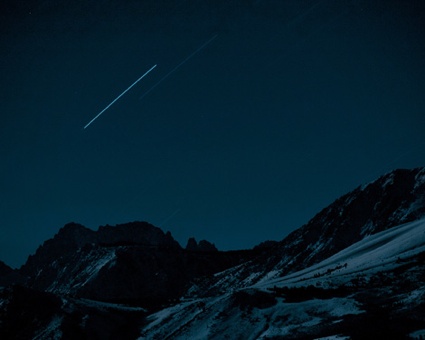 Trevor Paglen, Four Geostationary Satellites Above the Sierra Nevada, 2007
Trevor Paglen, Four Geostationary Satellites Above the Sierra Nevada, 2007
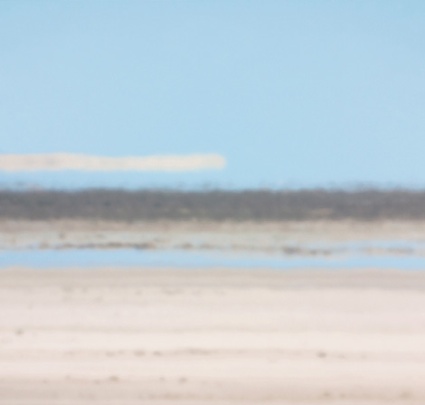 Trevor Paglen, Chemical and Biological Proving Ground No 2, 2006, Dugway, UT
Trevor Paglen, Chemical and Biological Proving Ground No 2, 2006, Dugway, UT
Both Limit Telephotography and The Other Night Sky have received wide coverage in the press. Did this attention to ‘the black world’ have some consequence in the access you had to information?
It’s easier now! People get in touch with me because they’ve heard of who i am and because of that too, it’s easier to stay out of trouble.
We have this idea that secrecy is this perfectly oiled machine but the secrecy system is not all that organized. Also we imagine that there is one single brain orchestrating secrecy behind the whole State but this is not the case. Lots of things are contradicting each other. The secrecy system is internally inconsistent but also incoherent.
Who contacts you exactly? People from the military?
Yes, but i’d rather not go into details about who they are.
But now that your books and photos have put the spotlight on what should not be revealed, have you ever heard of bases that had to be closed or covert activities that had to be re-scheduled because of the attention you brought to them?
Yes! A lot of the infrastructure of the rendition program had to be modified because of the way journalists, human right activists and researchers have turned it into a political issue and made it public. But now we have the drone assassination programs which are a kind of version 3.0. of the rendition program.
What should the Black World matter to us beyond the anecdote and the fascination for the hidden? Why should we fear? We are not terrorists after all…
Well, I can only talk from an American perspective. The Black World is a State that is inside the State and it works differently. It’s monarchic in the sense that it’s not a democracy. It is run by generals and ultimately by the President. There’s very little overview of it by other parts of the government and obviously by the people. It has a tendency to change everything around it to its own image.
For example, if you want to build a secret plane then you need first a secret factory to build it. Thousands of workers and managers will be working in that plane factory, they have to swear secrecy and you have to ensure that they will indeed keep the secret. That means that social engineering will also have to be organized. All this will require a lot of money which you obviously can’t get from the congress. So you have to find ways to fund your project without ever telling anyone how you’re going to use that money. Once you have the planes, you need a secret airbase. But how do you create a place on the surface of the Earth that will remain secret? So you build that place and claim that it doesn’t exist. Everything you do is outside of the court system so you also need to set up new laws which are actually not even laws since they haven’t been voted by the congress. So you start to create your own laws and legislation. Over time, the rest of the State starts to look more and more like the secret part of the State. It’s that structural organization that people should be concerned about, because illegal things are bound to happen where there is no oversight. That’s what happened with the rendition flights and torture program and recently with the drone assassination program.
Thanks Trevor!
Architecture of Fear remains open at Z33 in Hasselt, Belgium through December 31, 2011. Entrance is free.
Previously: Architecture of Fear, ‘The Villages’, empty capsules for dream, Dutch lifestyle and Discussing democracy, torture and secret services with Jill Magid.
